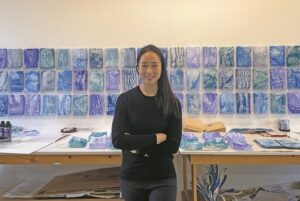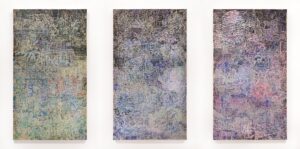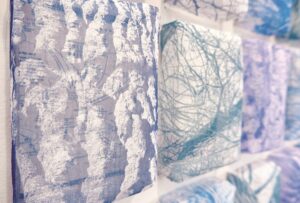An imposing triptych — greenish on the left, then bluish, then purple — hangs on one wall of Siennie Lee’s studio at the Fine Arts Work Center in Provincetown. Its abstraction barely fades as you draw nearer, even as the geometry of its painstaking detail emerges: hidden behind the rectangles and ovals are veiled bodies, interlocked on each panel.

“It looks like nature scenery at first glance,” Lee says. “But I left some small hints that some images may be hidden inside.” She’s been working on Foliage of the Seas this winter as part of her FAWC fellowship and will be exhibiting her work at the next Fellow Friday event on March 24.
Each panel in the series looks at women’s rights from a different angle. On the left is an abstraction of photos Lee pulled from news articles documenting pro-choice rallies. The center piece was inspired by a movement organized by S. Emsaki, FAWC’s visual art fellowship coordinator, and focuses on women’s rights in Iran: scissors, symbolic of haircuts as an act of resistance for Iranian women, are enmeshed in shapes and shades of blue. The swaths of pink in the painting on the right are revealed upon a closer view to be a sea of pussy hats, symbolic of women’s marches around the world.

The paintings are subtly translucent, painted with water-based ink on silk that Lee brought with her from South Korea. The stenciled shapes in each panel serve as aesthetic and figurative connective tissue. “I regarded the geometric shapes as nonverbal languages,” she says.
Lee was born and raised in South Korea. She received her B.F.A. and M.F.A. in oriental painting from Seoul National University and freelanced for Samsung as a travel writer while she was a student. She earned a second M.F.A. in 2022 from Alfred University in western New York State and studied in Düsseldorf, Germany for two of her four semesters there.
Lee recalls scrolling through news articles in a New York café when she glanced out the window and was struck by the thrum of daily life outside. The moment had a formative impact on her work, imbuing it with a social consciousness that Lee says wasn’t there before.
“When I came to study art in the United States,” she says, “I was humbled by the realization that I was only a small speck in the whole large fabric of society.” She says that social organismic theory — which conceives of society as a living organism — became her “big thing.”
This philosophy is captured in A Witness Tree, an ongoing lithography and cyanotype series that she has been creating since her arrival in Provincetown. Lee was enchanted early in her time at FAWC by a 50-foot cottonwood tree on Pearl Street, just off Commercial.

“Every time I see it, I think about the history it must have seen,” she says.
Since October, she’s photographed the tree every few days from a different angle and printed it via gum transfer — a lithography technique using photographic images — in aqua-tone ink on chiffon. She then selects an image from a news story published the same day and prints it as a cyanotype, a technique she learned at FAWC. The printed chiffon is then combined with the cyanotype, yielding a panel in which a scene of broader significance is visible in pixels through Pearl Street flora.
Lee says that it’s important that each piece incorporates two different images that are archived on the same day. “I want to see the stories they make together,” she says. So far, the series has 90 component parts.
Before her current project, Lee’s art involved installations of chiffon. “I’d hang it from the ceiling and people could walk through,” she says. But her work has become more methodical and precise — to the point where these days, she says, “my parents feel their influence as scientists in my work.”
It’s an evolution that’s in keeping with her origins as an artist. While she loved school as a child, she says she frequently found herself overwhelmed by academic pressures. Her parents, both chemists, urged her to sign up for painting classes as a means of relieving her stress.
“It just opened my eyes,” Lee recalls, adding that she was 14 years old when she realized that art was her calling. “Art is not just a pastime,” she says. “It’s my vocation.”
Her recent work both resists and expands on creative constraints by embracing a scientific commitment to precision. One work-in-process, Fading Feathers, incorporates the migratory patterns of endangered bird species. Lee used mapping software to overlay the routes and then transcribed them onto a larger canvas to create an artistic commentary on climate change. What first appears to be a tight tangle of white arrows is often seen as something more by those sensitive to the ecosystem of the Outer Cape: “The funny thing is a lot of people here have recognized right away that this is about migratory bird patterns,” Lee says.
Working on the Outer Cape has influenced Lee in other ways as well. Blue has become the dominant hue in her work since she arrived in Provincetown. “It’s definitely from the ocean,” she says. Lee’s art acclimatizes to wherever she finds herself — a testament to the way she observes and archives what’s happening around her contextualized in the larger world.
“My time so far at FAWC has been like a sanctuary,” says Lee. “It’s allowed me to delve into the fundamental questions underlying my work.”
FAWC Fellow Friday
The event New work by visual art fellow Siennie Lee and writing fellows Bhion Achimba and Kim Coleman Foote
The time: Friday, March 24, 5 to 8 p.m.
The place: Fine Arts Work Center, 24 Pearl St., Provincetown
The cost: Free; see fawc.org for information
